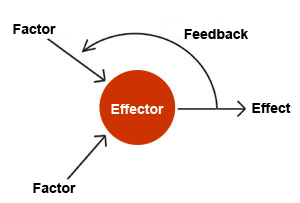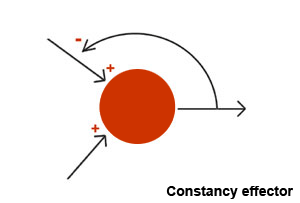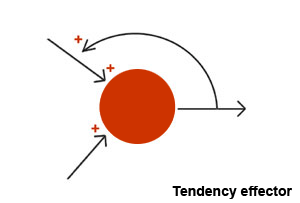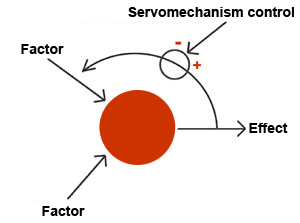Tool Module: Cybernetics
Louis
Couffignal, one of the pioneers of cybernetics, defined it as “the art of assuring
efficiency of action.” A less poetic definition is that cybernetics is the
science of dynamic relations between the parts of a whole, meaning relations
that change over time.
Cybernetics has applications in industry
and biology as well as in art, not to mention computer science, which can be regarded
as an application of cybernetics. The many different Internet-related terms that
start with “cyber-“ (cyberspace, cybercafé, etc.) are all derived from the word
cybernetics.
Because cybernetics is so closely linked with the concepts
of structures and levels of organization, it forces us to clearly define certain
of their elements, whose interaction can be diagrammed as follows.

First, an effector is a mechanism that produces certain
effects.
Factors are the necessary
conditions for the operation of the effector.
Feedback
is a phenomenon by which effects can influence one or more factors that act on
the effector. This feed-back makes it possible to pursue a goal–in other words,
to move toward a desired state or maintain a behaviour despite disturbances due
to the external environment.
The purpose of an effector is to achieve
a certain value of the effect. An effector that tries to keep the effect at a
constant value is called a constancy effector. The vast majority
of the physiological mechanisms that help to maintain internal equilibrium in
living organisms are constancy effectors.
On the other hand, an effector
that tries to move the effect toward a maximum value is called a tendency
effector.
A constancy effector is said to be “regulated” if
it is subject to feedback whose sign is the opposite of the factor’s.

In contrast, tendency effectors are subject to feedback whose sign is the same
as that of the factor on which it acts.

The term "regulator" refers to a constancy effector that
maintains equilibrium at close to an ideal value, fluctuating around a mean thanks
to the negative feedback loop.
A regulator can also have a servomechanism.
A servomechanism is a control that is external to the system and that acts on
the feedback loop to modify its value.

For example, a thermostat set to keep the temperature of a room at 21
degrees Celsius is a regulator. But if we want to raise the room temperature to
25 degrees, we must intervene from outside the system by moving the thermostat
control to the new value.
This concept of servomechanisms is central
to the science of physiology, because it implies the existence of various levels
of organization in living organisms. Regulated systems are found at every level
of organization in living organisms. But each of these regulators is also subject
to a servomechanism: the information that it receives from the higher levels surrounding
it. In living systems, servomechanisms are what allows the various levels to work
together harmoniously to maintain the structure of the organism as a whole.
For example, at the molecular level, the set of enzymes necessary for a particular
biochemical reaction can be regarded as a regulator. But this regulator is influenced
by an external control from the next level up–in this case, the cell. The cell
is another regulated system, as exemplified by the way that a neuron maintains
its resting membrane potential. But the cell too is subject to a servomechanism:
the information that it receives from the organ to which it belongs.The organ
in turn receives servomechanism control information from the system to which it
belongs (nervous, vascular, endocrine, etc.), the system does so from the organism
as a whole, and the organism does so from its external environment.
This chain of servomechanisms, linking the molecule to the organism to humanity
as a whole within its cosmic environment, is the result of the evolution of living
structures. This evolution itself is part of the tendency of the universe to become
more complex locally.
An organism is thus an open system from an information
standpoint, because information flows down to every level of organization from
the level above it. But the information also flows upward, because all the levels
of organization are already contained in potential form in the DNA of the fertilized
egg.
In contrast to the "structural information"
that is supplied by the genes and modified by the environment to produce a particular
individual, we can therefore also distinguish "circulating information",
which is carried mainly by the nervous and endocrine systems.
While
structural information serves, for example, to distinguish a person from an elephant,
circulating information serves to maintain the organism’s overall structure and
the integrity of each level of organization. By accomplishing its own purpose,
each of these regulated systems helps to accomplish the purpose of the system
as a whole. And it is the circulating information that accomplishes much of the
work of the servomechanism, or external control, at every level of organization.
Cybernetics thus constitutes an essential tool for understanding living
things, because it reveals the levels of organization and the dynamic linkages
between them. The concept of servomechanisms also helps us to understand the concept
of structure, meaning the entire set of relationships among all
the parts of a whole. A structure cannot be reduced to the sum of its parts, because
these parts establish relationships among themselves, and it is the entire set
of these relationships that defines the structure of an organism. "The whole
is greater than the sum of its parts."
Thus, in any organism, the
structure consists of a hierarchy of levels of organization, each of which constitutes
the control of a servomechanism that ensures the functional cohesion of the whole.
We can thus clearly see why cybernetics is described as the science that studies
the dynamics of structures.

This nested hierarchy of organizational levels is sometimes compared
with a set of nested Russian dolls. But this analogy is not really very accurate.
You can remove all the smaller dolls from inside the largest one, and it will
still retain its form. But if you did the same thing to a living body, you would
destroy its servomechanisms and turn it into a corpse.
As cybernetics
tells us, life is both a system and information, whereas a machine is a system
that feeds on information. If you cut the power to a computer, it will no longer
be able to use the information supplied to it, but it will still be a computer,
ready to work again when the power comes back on. But if you cut off a plant’s
sunlight or an animal’s food, it will quickly become an inert body and start to
decompose. Its structure coincides with the energy that feeds it and that it transforms
or, more precisely, informs.
